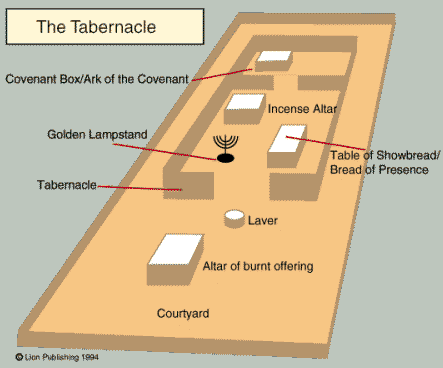The Tabernacle: A Blueprint of Worship
God’s Dwelling Place Among His People
“Let them make me a sanctuary, that I may dwell in their midst.”
The Tabernacle was a portable sanctuary commanded by God, serving as a detailed, physical representation of a profound spiritual truth: a holy God created a way to live among His people. It was more than a tent; it was a roadmap to redemption, with every element pointing toward the ultimate fulfillment in Jesus Christ.
Exodus 25:8
A Journey to God’s Presence
The Tabernacle was divided into three main areas, each representing a step closer to the presence of God. This layout teaches a crucial lesson about holiness, sacrifice, and the only way to approach the divine.
1. The Outer Court
Who: All Israelites
The first area, open to any Israelite bringing a sacrifice. It represents the initial step of approaching God: acknowledging sin and the need for atonement through a blood sacrifice.
2. The Holy Place
Who: Only Priests
A sacred chamber where priests ministered daily. It symbolizes a life of fellowship, sustained by God’s provision (Bread), guided by His revelation (Light), and centered on communication (Prayer).
3. The Holy of Holies
Who: High Priest, Once a Year
The innermost sanctuary, housing the Ark of the Covenant. It represented God’s throne room on Earth, a place of ultimate holiness, separated from humanity by a thick veil.

Symbolism of the Sacred Furniture
Each object within the Tabernacle was divinely designed to teach about Christ’s future redemptive work.
Bronze Altar
The place of sacrifice. It stood at the entrance, signifying that the only way to begin an approach to God is through the shedding of blood for the forgiveness of sins.
Leviticus 17:11
Christ, The Lamb of God
Jesus is our sacrifice, the “Lamb of God, who takes away the sin of the world.” His death on the cross was the one, perfect sacrifice for all.
John 1:29
Christ, Our Cleansing
Jesus washes us clean from our sin, sanctifying us “by the washing of water with the word.”
Ephesians 5:26
Bronze Laver
A basin of water for the priests to wash before ministering. It symbolized the need for daily cleansing and purification from the defilement of the world.
Exodus 30:19-21
Table of Showbread
Held twelve loaves of bread, representing God’s life-sustaining fellowship and provision for His people.
Leviticus 24:5-9
Christ, The Bread of Life
Jesus declared, “I am the bread of life; whoever comes to me shall not hunger.” He provides true spiritual sustenance.
John 6:35
Christ, The Light of the World
Jesus proclaimed, “I am the light of the world. Whoever follows me will not walk in darkness, but will have the light of life.”
John 8:12
Golden Lampstand
The only source of light inside the Holy Place, its seven lamps symbolized divine wisdom, revelation, and the light of God’s presence.
Exodus 25:31-40
Altar of Incense
Placed before the veil, the rising smoke of the sweet incense symbolized the continuous prayers of God’s people ascending to His throne.
Psalm 141:2
Christ, Our Intercessor
Jesus “is at the right hand of God” and “is interceding for us,” ensuring our prayers are heard.
Romans 8:34
The Great High Priest
The book of Hebrews contrasts the role of the temporary, sinful Levitical High Priest with our eternal, perfect High Priest, Jesus Christ. The old system was a shadow; Christ is the reality.
| Attribute | Levitical High Priest | Jesus Christ |
|---|---|---|
| Access | Once a year | Entered once for all |
| Sacrifice | Blood of animals | His own blood |
| Nature | Sinful, mortal | Sinless, eternal |
| Covenant | Mediator of the Old | Mediator of the New |
See Hebrews chapters 8-10
One Sacrifice for All Time
Unlike the repetitive sacrifices in the Tabernacle, Christ’s sacrifice was a singular, all-sufficient event that secured eternal redemption.
Hebrews 10:12
The Veil Was Torn
At the moment of Christ’s death, the massive veil separating the Holy of Holies was torn in two, from top to bottom. This divine act signified that the barrier between God and humanity was removed. Through Jesus, we now have direct access to the throne of God.
Matthew 27:51
How We Approach God Today
The Tabernacle’s pattern still teaches us the principles for approaching God. Because of Christ, we can confidently draw near.
Hebrews 10:19-22